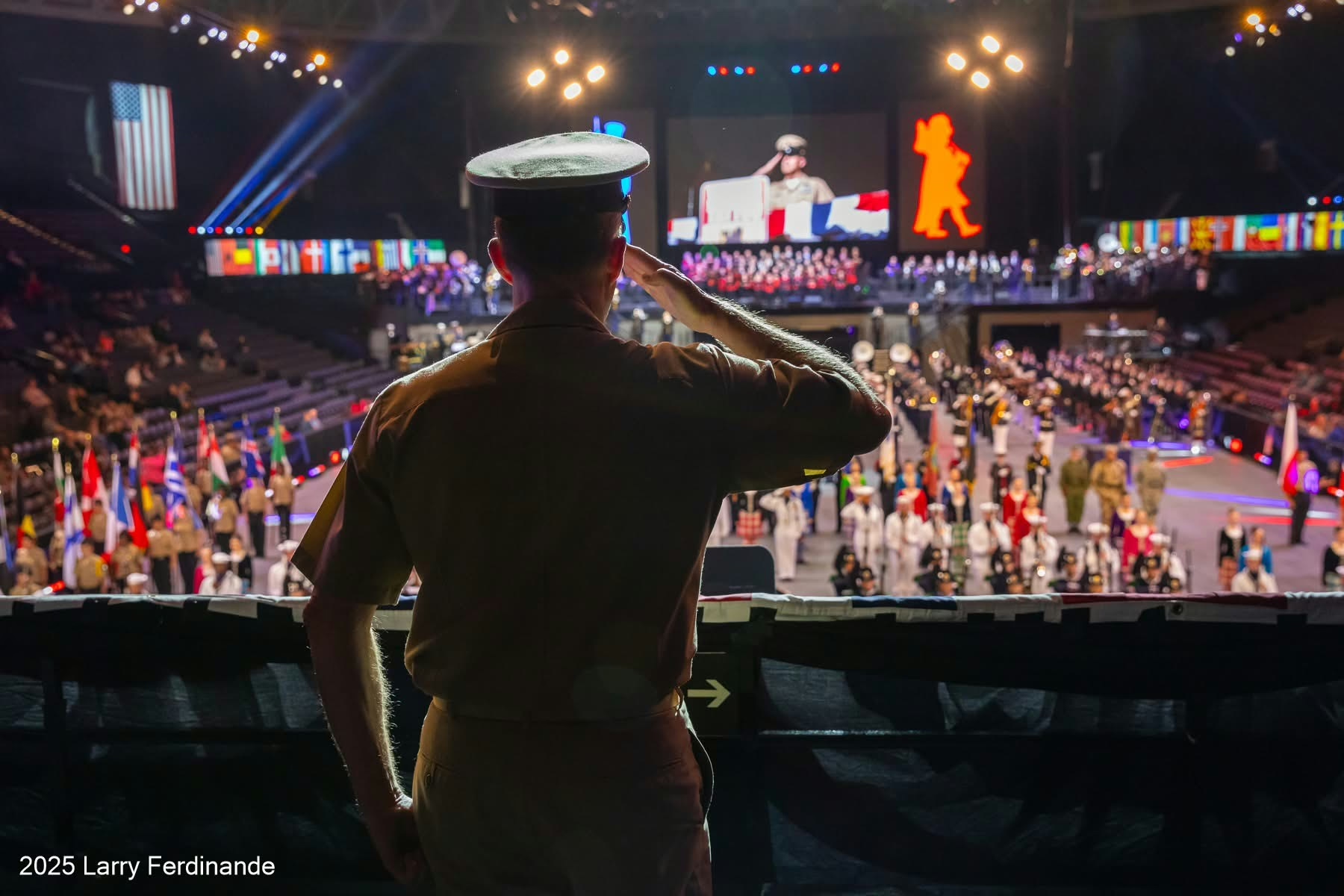Photo caption: Nimitz-class aircraft carrier USS Abraham Lincoln (CVN 72), left, and the guided-missile destroyer USS Frank J. Petersen Jr. (DDG 121) transit the Singapore Strait, Aug. 15, 2024. Both ships were built by HII – CVN 72 at NNS, and DDG 121 at Ingalls Shipbuilding. (U.S. Navy photo by Mass Communication Specialist Seaman Joey Sitter)
Aug. 23, 2024
HII’s Weekly News Digest is compiled every Friday by the Corporate Communications team to summarize and highlight news stories of significance to the company.
Richard M. McCool, Jr. (LPD 29) Sails Away From Ingalls: WLOX reported Thursday that San Antonio-class amphibious transport dock ship Richard M. McCool, Jr. (LPD 29) sailed away from HII’s Ingalls Shipbuilding division on Thursday. The ship is heading for Pensacola, Florida, where the Navy is scheduled to hold a Sept. 7 commissioning ceremony. Richard M. McCool, Jr. was delivered to the U.S. Navy in April and is the 13th San Antonio-class ship delivered by Ingalls. The ship is the final Flight I transition ship before Ingalls begins producing the LPD Flight II line. Richard M. McCool, Jr. is the first in the class to undergo the installation and activation of the Enterprise Air Surveillance Radar, SPY-6(V)2, rotating variant, S-Band radar. SPY-6(V)2 provides the U.S. Navy with a common hardware variant for aircraft carrier and amphibious ships and commonality with the SPY-6 Family of Radars. Currently, Ingalls has two Flight II LPDs under construction including Harrisburg (LPD 30) and Pittsburgh (LPD 31). In March 2023, Ingalls was awarded a modification to the contract for the procurement of the detail design and construction of Philadelphia (LPD 32).
First-Of-Its-Kind Unmanned Control Room Build On Aircraft Carrier: Breaking Defense reported on Friday, Aug. 16, that the U.S. Navy has finished installing a new control room aboard USS George H.W. Bush (CVN 77) that is designed for the crew to operate and monitor the service’s next-generation unmanned tanker MQ-25A Stingray. Capt. Daniel Fucito, unmanned carrier aviation program manager, said the new unmanned center — named the Unmanned Air Warfare Center — will make up the “foundation” of how the Navy will pilot both MQ-25 and other unmanned aircraft on aircraft carriers moving forward. USS George H. W. Bush is scheduled to test the new control center early next year. Navy Times reported on Wednesday that the ground control station’s installation was part of a years-long effort that took place aboard USS George H. W. Bush during multiple ship maintenance stints and between deployments, according to Naval Air Systems Command. While the control room will initially support the Stingray, it will also be used for other services’ unmanned systems, such as the Air Force’s collaborative combat aircraft program, which seeks to pair air drones with unmanned aircraft in a so-called “air wing of the future.”
Navy Retooling Its Approach To XLUUVs: Inside Defense reported on Friday, Aug. 16, that the U.S. Navy is aiming its focus on successfully fielding unmanned underwater vehicles. The service specifically wants to build a significantly better XLUUV, as well as UUVs with longer endurance, said Greg Avicola, a DARPA program manager. The Navy is trying to determine how to place vehicles in the water for extended periods without human intervention, and it is creating an “autonomy roadmap” to help solve that question. Dorothy Engelhardt, director for unmanned systems in the office of the deputy assistant Navy secretary for ships, said the roadmap will guide the Navy moving forward. “I call it my capability over time curve,” Engelhardt said. “So, the idea is to figure out what missions we want to be able to achieve, and what time frame. And then based on that, we’re building this roadmap to figure out how we can continue to return these technologies to meet those objectives, and where we need to make our investments.”
| Social Media Highlight Of The Week
Posted Thursday on HII’s LinkedIn page:
“The recipients of the 2024 HII Compass Award for Compliance were honored by senior staff on Thursday, August 22. 🏆 The Compass Awards for Compliance are given annually to employees who stand out for their contributions to our company’s culture. The first award was presented in 2022. This year’s honorees include: Corporate Office: Dawn Smith, Corporate Director, Culture and Ethics Ingalls Shipbuilding, a Division of HII: Burt Adkison, Director, Industrial Engineering Mission Technologies, a division of HII: Doris Jones, Program Cost Control Analyst 3, Business Management Newport News Shipbuilding, A Division of HII: Dave Vandegrift, Director, Waterfront Support Please join us as we congratulate this year’s winners! 👏” |
Coast Guard’s Icebreaker Budget Balloons 60%: Breaking Defense reported on Wednesday that the Congressional Budget Office has released a report that estimates the U.S. Coast Guard’s program to build three new heavy icebreakers will cost roughly $5.1 billion, a 60% increase over the service’s current projections of $3.2 billion. The report was created for the House Homeland Security Committee. It’s common for CBO and the Coast Guard or Navy to disagree on the projected price of a future ship, and the report does note the Coast Guard is calculating its own updated cost estimate and plans to release those figures later this year. Predicting the price of the Polar Security Cutter is particularly difficult because analysts often use existing ships to help them model what a future ship should cost. In this case, the United States has not produced a heavy icebreaker in more than four decades. Defense Daily reported on Wednesday that the CBO’s estimate precedes the actual start of construction of the first cutter, which the Coast Guard hopes will begin later this year with delivery in 2029. The detailed design and construction contract was awarded in April 2019 to VT Halter Marine, which was subsequently acquired by Bollinger Shipyards. CBO says that as of July the design of the PSC is 59% complete.
Boeing, Lockheed Martin In Talks To Sell ULA To Sierra Space: Reuters reported on Friday, Aug. 16, that Boeing and Lockheed Martin are in talks to sell their rocket-launching joint venture, United Launch Alliance, to Sierra Space in a deal that would be valued at $2 billion to $3 billion. The potential sale comes after years of speculation about ULA’s future and failed attempts to divest the joint venture over the past decade. In 2019, Boeing and Lockheed Martin reportedly explored selling ULA but couldn’t agree on terms with potential buyers. A potential deal would be significant for Sierra Space, which spun off from Sierra Nevada Corp in 2021 to focus on bringing to market its Dream Chaser spaceplane and building a private space station habitat with Blue Origin. The Reuters report does note that talks could end without a deal being struck.
HII’s Weekly News Digest is produced by HII’s Corporate Communications team and posted to Homeport every Friday.
Please note: Social media is blocked on HII computers for most employees. Employees are encouraged to visit HII’s Facebook page and other social media sites on personal time and from non-work devices.
Send feedback to: HII_Communications@hii-co.com.













